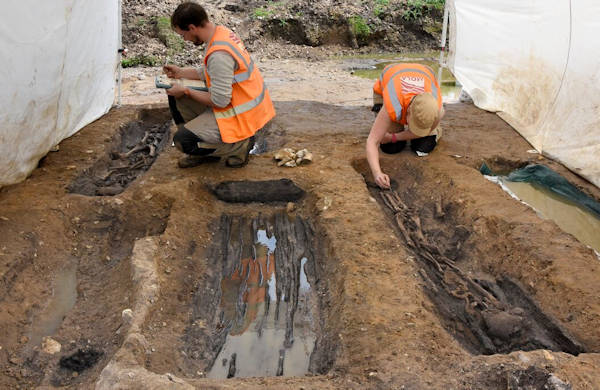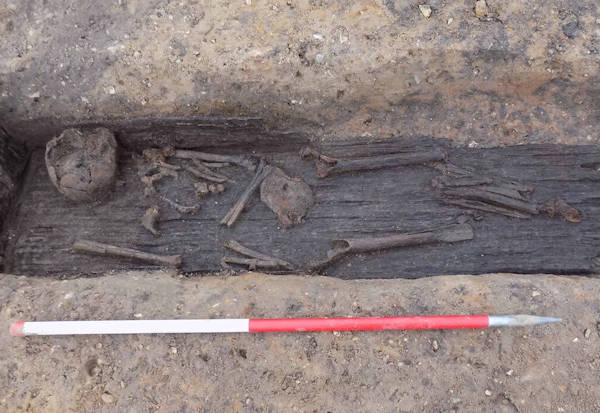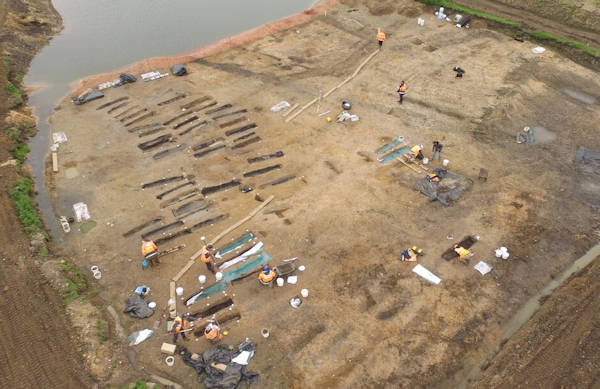
Norfolk dig reveals Anglo-Saxon Christian community
Evidence of one of the earliest Christian communities ever to be discovered in Britain has been uncovered at an archaeological dig at Great Ryburgh in Norfolk. Keith Morris reports.
An early and important Anglo-Saxon cemetery has been uncovered by archaeologists from MOLA (Museum of London Archaeology) in an excavation funded by Historic England in advance of a planned conservation and fishing lake and flood defence system.
The waterlogged conditions of the River Wensum valley led to the remarkable preservation of burials that are extremely rare in the archaeological record, including plank-lined graves and tree-trunk coffins dating from the 7th-9th century AD.
Archaeologists have revealed evidence that this may have been the final resting place for a community of early Christians, including a timber structure thought to be a church or chapel, of which there are few examples from this period. The wooden grave markers, east-west alignment of the coffins and the evident lack of grave goods, all support the Christian origins of the cemetery.

Duncan Wilson, Chief Executive of Historic England said: "These rare and exceptionally well-preserved graves are a significant discovery which will advance our understanding of Middle-Saxon religious beliefs and rural communities. This site has immense potential for revealing the story of the community who once lived there."
Tim Pestell, curator at Norwich Castle Museum, where the finds from the dig will be kept, said: “This find is a dramatic example of how new evidence is helping to refine our knowledge of this fascinating period when Christianity and the Church were still developing on the ground. Detailed analysis of the cemetery provides the hope of better understanding the actual people living according to this new religion.
"The site was in use in the heyday of the Anglo-Saxon kingdom of East Anglia and positioned next to a strategic river crossing. As with much of East Anglia at this early date, we have no documentary sources that relate to this site and so it is archaeological finds like this that are crucial in helping us to understand the development of the kingdom,” said Tim.
James Fairclough, archaeologist from MOLA said: "The combination of acidic sand and alkaline water created the perfect conditions for the skeletons and wooden graves to survive, revealing remarkable details of Christian Anglo-Saxon burial practices."
Gary Boyce, land owner of Wensum View, said: "It's really exciting to have such a rare and important heritage site on my land. We set out to create a lake to maximise conservation and biodiversity, to alleviate flooding in the river valley and create a new spot for anglers to fish, and along the way have revealed the hidden secrets of the area's past."
Matthew Champion, the local archaeologist who made the initial discoveries at the site said: "This discovery is going to significantly add to our understanding of just how the settlement patterns in the river valley developed over time, and is a fantastic example of what can be achieved by working closely with local landowners."

Anglo-Saxon coffins seldom survive because wood decays over time. Evidence to date has largely consisted staining in the ground from decayed wood.
The 81 dug-out coffins discovered comprise oak trees split in two length-ways and hollowed out. This type of coffin is first seen in Europe in the Early Bronze Age and reappears in the early medieval period. From Britain they are mentioned in antiquarian records from the late 19th century but this is the first time they have been properly excavated and recorded by modern archaeologists.
The burials, in hollowed out logs, were positioned in the lower half and the upper half rested on top to form a lid. Although they aren't decorative, it would have taken considerable effort to hollow a single coffin, an estimated four man days. The fact that evidence for similar burial rites is also found in earlier cemeteries may signify the blending of pagan and Christian traditions.
The six plank-lined graves are very rare in in this country and these are believed to be the earliest known examples from Britain. The graves were cut into the ground, lined with expertly hewn timber planks, the body placed inside and planks positioned on top to form a cover. The relationship between the two burial types is not fully understood, but may denote an evolution in burial practices. Tree ring dating is being undertaken to date the timber.
The discovery is shedding light on a previously unknown religious site and early Christian rural community. Continued research and scientific testing, in the form of ancient DNA, stable isotope and dental calculus analysis, will help to develop biographies for the people buried. Archaeologists hope to be able to say more about where these people came from, whether they were related, and what their diet and health were like, once research is complete.
Pictured above is the site of the find at Great Ryburgh and archaeologists from MOLA working on the site of the graves. Pictures are copyright of MOLA.
|